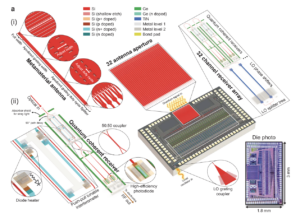Quantum Wi-Fi Future: Quantum Tech Could Power Super-Secure Wireless Communication

Insider Brief
- Caltech scientists offer an innovative design for a quantum wi-fi network.
- The quantum phased array system includes a silicon photonic chip equipped with 32 antennas that can both transmit and receive quantum signals.
- The design offers several advantages including enhanced security, room temperature operation and scalability.
Researchers at the California Institute of Technology report that they incorporated quantum physics into traditional wireless network to create a new system that would be, among other things, compact, scalable and secure. The researchers refer to the innovation as the quantum phased array (QPA), according to a paper posted on the pre-print server ArXiv.
The QPA, once fully developed, would be a compact, integrated system that merges photonic and electronic technologies to manage free-space quantum information — or, transmitting quantum information through open air or space, rather than through wires or fiber optics. The researchers write that this advance could potentially lead to highly secure, quantum-encrypted wireless communication, which would represent a considerable leap forward from today’s tech.
How the Quantum Phased Array Works
The QPA uses a silicon photonic chip equipped with 32 antennas that can both transmit and receive quantum signals. These antennas are meticulously designed to handle squeezed quantum light, a form of light with precisely controlled properties that can be used for various quantum information processes.
This chip also includes more than 1000 electronic components within a minuscule area of 3mm by 1.8mm — that’s about the size of a single grain of rice. Unlike many quantum devices that require extremely low temperatures, the QPA operates at room temperature, simplifying its integration into existing technology infrastructures.
A central feature of the QPA is its ability to establish reconfigurable wireless quantum links. The researchers achieved this through a large-area metamaterial aperture that facilitates low-loss coupling between free-space beams and the chip. By coherently processing quantum signals in the radio-frequency domain, the system effectively mitigates the geometric loss typically encountered in free-space quantum communications. This means that even as the quantum signals spread and lose intensity over distance, the QPA can still process these signals with high fidelity.

Real-World Applications
Scientists suggest that QPA would have potential real-world applications from securing wireless devises to powering sensors. According to Carlo Ottaviani of the University of York, who told New Scientist, the device could enable quantum-encrypted wireless communication within buildings, enhancing the security of data transmissions for the growing Internet of Things (IoT). The IoT, which includes devices from smart home gadgets to industrial sensors, often faces security vulnerabilities. Quantum encryption could provide an additional layer of protection against hacking attempts.
Ottaviani notes that while the QPA is a promising development, further refinements are necessary. For example, scientists will need to improve the chip’s ability to accurately detect quantum light from greater distances is crucial for its practical deployment. However, he is optimistic about its potential, telling New Scientist, “I see a bright future for this – the future is clearly quantum.”
The research team conducted several key experiments to demonstrate the capabilities of the QPA. In one experiment, the team transmitted squeezed light via a laser to the chip. The chip successfully received and analyzed the quantum information, showing that it can handle real-world quantum communication scenarios.
The QPA’s antennas can be programmed to detect signals from specific directions and to extract maximum information from noisy environments. This feature is particularly beneficial for applications requiring precise signal detection and processing, such as quantum sensing and quantum computing.
Overcoming Challenges
One of the longstanding challenges in quantum communication, as mentioned, is geometric loss, which occurs when the quantum signal spreads out over distance, leading to significant signal degradation. The QPA addresses this issue by using wavefront engineering, a technique that allows the active manipulation of an electromagnetic field to focus the signal more effectively. By extending this concept to quantum fields, the QPA can maintain high-quality quantum links over longer distances.
The QPA also incorporates optoelectronic processing, combining optical and electronic techniques to handle continuous variable quantum information. This integration not only improves the efficiency of quantum information processing but also opens new avenues for the development of large-scale quantum systems.
Future Prospects
With QPA’s ability to operate at room temperature, combined with its compact and scalable design, the system could make it a viable candidate for widespread deployment in various applications, from secure communications to advanced quantum computing. The researchers envision the QPA platform being used in a range of fields. As improvements in component efficiency continue, the path to real-world applications becomes clearer.
The team lists some of the system’s potential applications in the paper, including new approaches to quantum computing: “Demonstrated improvements in component losses chart a path toward deployment of our platform to real-world applications including microscopes, sensors and quantum communication transceivers, as well as potential investigations of fundamental physics research. Interfacing integrated quantum photonics with electronics in the same package enables novel engineering opportunities in realizing large-scale room-temperature quantum systems. Coherent processing of downconverted quantum optical information with RF or microwave integrated circuits could enable a low-loss optoelectronic approach to quantum information processing as a quantum analog of microwave photonics.”
